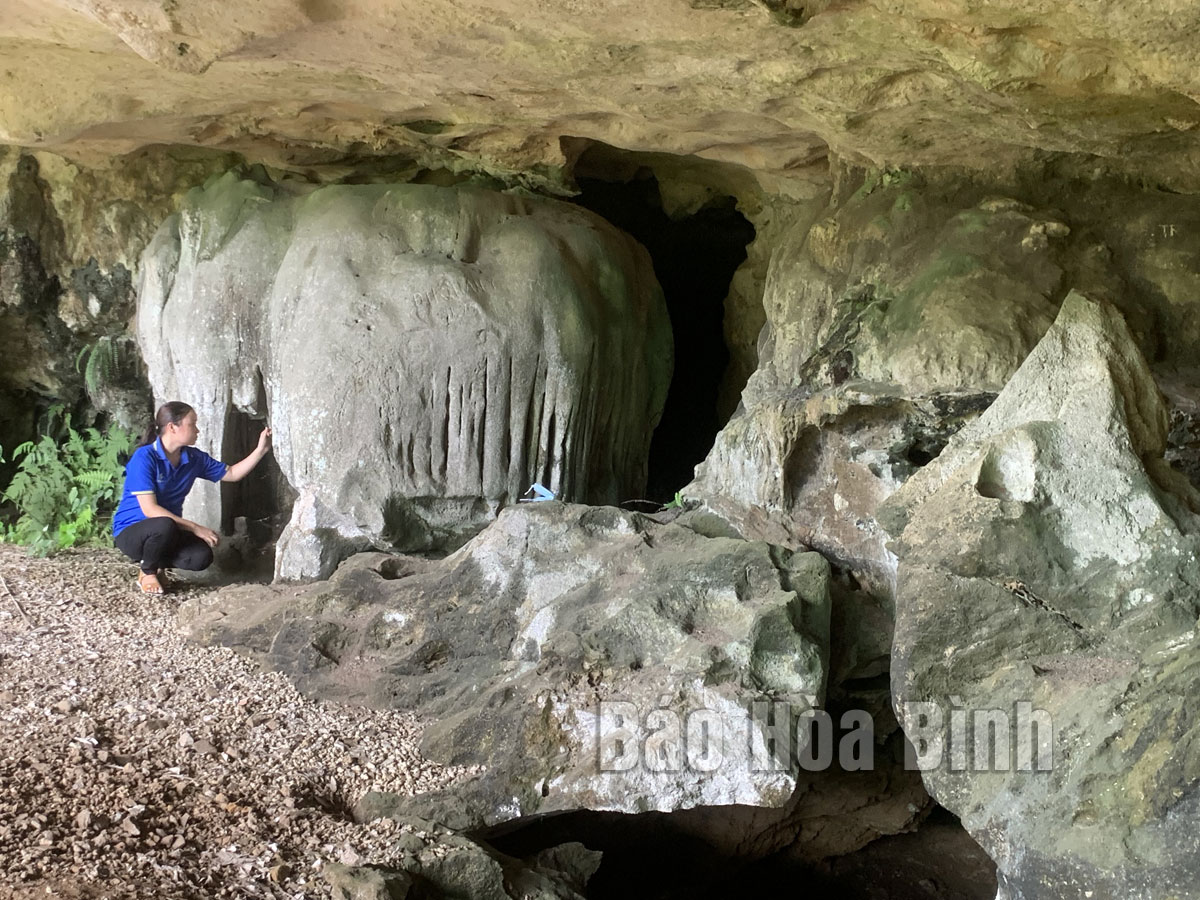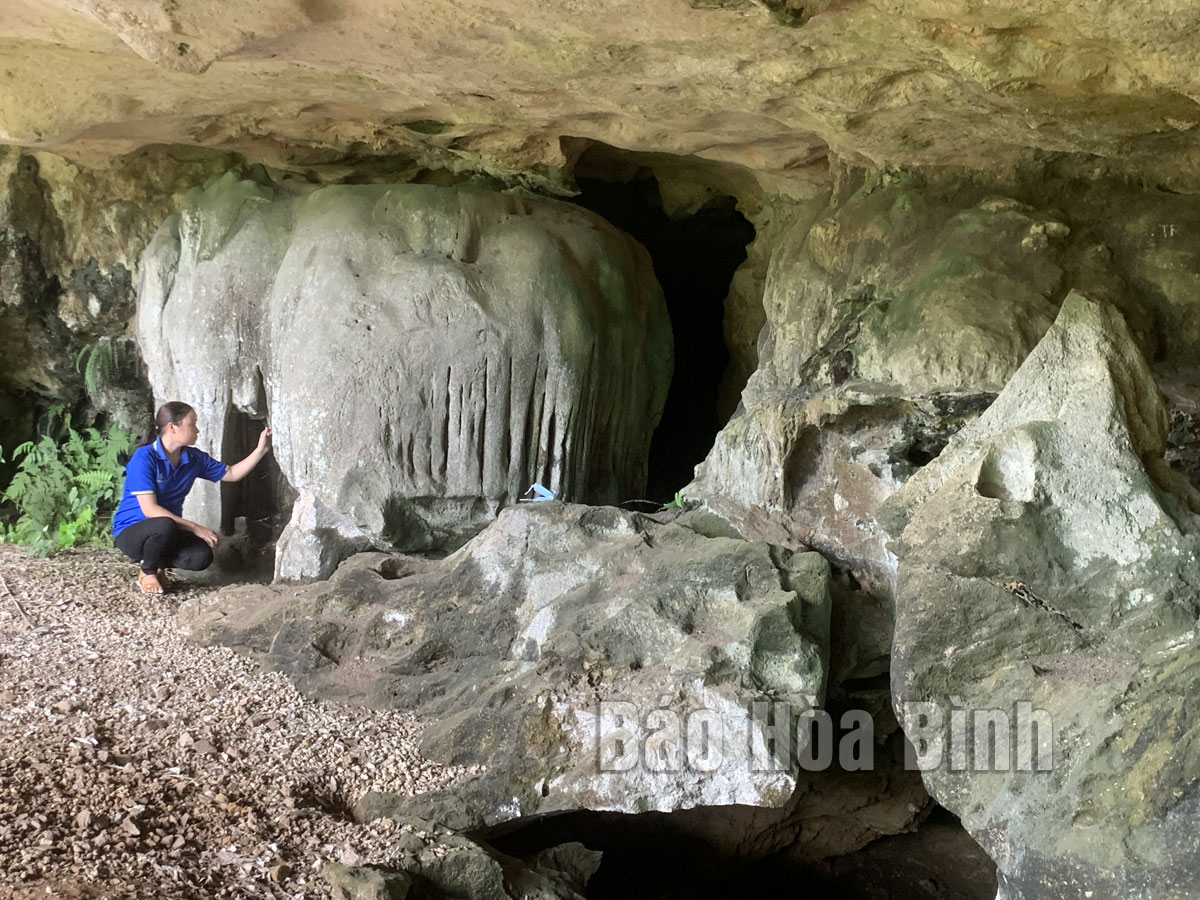
(HBO) - In the last days of July, we had the opportunity to visit the ancient archaeological site of Tam cave, in Lam Son commune (Luong Son). The cave is located in a double mountain with 2 parallel tops, standing independently, there is a stream flowing near the mouth of the cave. Tam cave is the residential place of the people in the stone age of Hoa Binh culture.
The the ancient archaeological site Tam cave in Lam Son commune (Luong Son) has unearthed many artifacts and it is the residence of the prehictoric people.
Together with the cultural officers from Lam Son commune, we went to Tam cave. The outside of the cave looks like a giant frog’s jaw. The cave door opens on a vertical cliff, being strewn with the white limestone and it has many large rocks blocking the way. The ceiling of the cave gradually rises from the inside to the outside, the floor of the cave is relatively flat, from the entrance of the cave, you can see many layered screw shells, the fossils on rocks, Hoa Binh stone tools and the imprints on the cliffsm and the cave dome.
The archaeological site of Tam cave was discovered and excavated by the French geologist Ms. Colani from 1930 - 1938. The results of excavation and the collected artifacts show that the site of Tam cave was the residence of the prehistoric people, belonging to the late Hoa Binh culture - the late Middle Stone Age.
In January 1964, The University of Hanoi sent a group of internship students to investigate and excavate the site of Tam cave. During this time, the group found the traces of the residence and living of the primitive people. The stone tools crudely hewn on one face or sharpened by the tongue and a few pieces of all kinds used for cutting trees, digging, hunting, killing animals. The shells and bone fragments were the vestiges of food, the burning lands and ash coals are places of fire, cooking, and heating. The site has a unique cultural layer, in which there are mainly screws and animal bones with the low fossil level. The culture layer is porous, there is no sterile layer between the cultural layers.
Through the excavations, they have obtained 851 artifacts, including 843 stone tools, 8 bone tools divided into 13 groups in Tam cave. Out of a total of 851 tools, there are 350 forming tools, 493 unforming tools, 683 single-sided or sometimes near-double-sided carefully chiseling tools, and 193 rudimentary chiseling tools. There is absolutely no pottery in Tam cave. Although in the total number of artifacts, the forming tools are less than the non-forming ones, however, when comparing to other sites of Hoa Binh culture, the ratio of forming tools here is quite high, in addition the carefully chiseling tools accounted for 81%. Currently, these artifacts are kept carefully in the warehouse of the Faculty of History - Hanoi University of Science and Humanities.
Tam Cave can be classified in the late Hoa Binh culture. In terms of stratigraphy, Tam cave is Hoa Binh cultural relic, the geological structure is similar to other sites of Hoa Binh culture. The conclusions on the stratigraphy and paleontology allow to confirm that the site of Tam cave belongs to the late Hoa Binh culture - the late Middle Stone Age based on the type of tool. The site of Tam cave was discovered and studied, contributing to understanding the relationship between the Northwestern culture of Hoa Binh and the localities in the Northern region, lighting up the tool-making techniques and pre-human life.
With its pristine landscapes, unique cultural heritage of Muong ethnic minority, and an expanding range of visitor experiences, Tan Lac district of Hoa Binh has fast become a captivating destination for both domestic and international tourists.
Until now, Sung village in Cao Son commune, Da Bac district remains the only Dao ethnic community in Hoa Binh province to develop a community-based tourism model. Beyond its untouched natural landscapes, cultural identity serves as the cornerstone attraction for visitors.
Alongside the diverse cultural identities of the Kinh, Muong, Tay, Thai, Dao, and Mong ethnic people, Hoa Binh province is also renowned as the "capital" of the northwestern Vietnamese cuisine, offering unique and distinctive dishes. At festivals, during Lunar New Year (Tet), or on significant family or community occasions, special dishes are prepared, leaving a lasting impression on visitors.
A Phong Linh (Yellow Tabebuia) flower garden in Thang village, Thach Yen commune, Cao Phong district is currently in full bloom, drawing a large number of visitors.
Community-based tourism has been thriving in Pa Co commune, Mai Chau district thanks to advantages in natural landscape and cultural identity.
Doan Ket commune of Yen Thuy district has recently held a ceremony to receive a certificate recognising Ta communal house as a provincial-level historical and cultural relic site.



